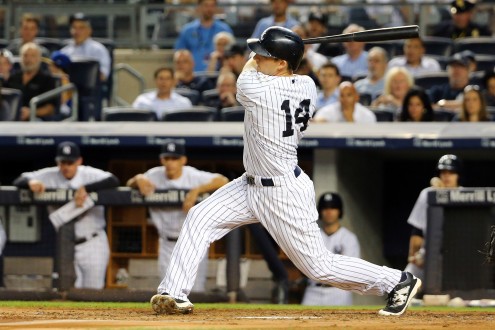As this is a subsection of Baseball Prospectus dedicated to the New York Yankees, it is quite likely that you, the reader, are familiar with Stephen Drew. For the uninitiated, Stephen Drew is the second baseman for the Yankees, and has been since around this time last year. He became a free agent after being acquired in a trade last season, and was then brought back for a year at a cost of $5 million. On paper, without looking at anything resembling his performance on the field, it would seem that the Yankees found someone that they liked and brought him back at a cheap cost.
Here’s the thing. Stephen Drew was once a good baseball player. In 2010 while playing for the Arizona Diamondbacks, Drew hit .278/.320/.438 while playing a solid shortstop and socking 15 home runs. That’s excellent, and led to a 5.3 WARP. That’s an amazing asset to have. This is not 2010, however. In 2015, Drew is hitting .201/.274/.385, playing a decent second base and has hit 16 homers. At first glance it appears that Drew has sold out for power in a big way. A low batting average combined with double digit home runs for a player on the wrong side of 30 conjures up that image. However, at a closer glance, we see that Drew has only struck out in 17.1 percent of his plate appearances this year. That’s down from his disastrous 2014 campaign, and he’s walking at almost the exact same rate. Naturally, that means he’s putting the ball in play more.
Here’s where things get interesting. When a player is not striking out at a prodigious rate, or walking at an especially high rate either, there are two general possible outcomes. The first is that of Ben Revere. Revere does not walk, and while he strikes out less often than Drew, Revere makes his living by slapping the ball all over the field and running very quickly to stretch singles into doubles. Revere hits a home run once every decade or so, but he’s still a useful player for his speed and range in the outfield. He won’t turn a franchise around, but he’s a useful supplementary piece. The other outcome is that of Drew, who makes insanely poor contact when he’s not depositing the ball in the right field porch. His line drive rate of 23.61 percent is lower than Omar Infante’s, and his overall 20.1 percent hard-hit rate (per FanGraphs) is the lowest of his career. Drew’s .201 BABIP is just a hair away from his actual .196 batting average.
The baseball world arbitrarily draws a line at .200 when it comes to batting average. We even gave the line a catchy name; the Mendoza Line. It’s a nice round number to be sure, and batting average isn’t even the greatest measure of offensive prowess to begin with. Batting average is the rate at which a player gets a hit in his at-bats. At-bats don’t include walks, as you all know, and a single counts for as much as a triple or a home run. Yet we take notice when a player slips below the fabled Mendoza Line because the vast majority of baseball players hit in the .200 range. Up until yesterday’s game, Drew hadn’t seen his batting average be .200 or higher since the middle of last year. Sometimes a player with a low batting average is still mildly productive due to a proclivity of walks and home runs. In 2012, Adam Dunn hit .204/.333/.468. He walked 105 times and hit 41 homers. He managed to be worth 1.9 WARP primarily because he hit the ball incredibly hard and walked a lot. Sure, he struck out 222 times. Yet Dunn was still a productive player despite his batting average.
Stephen Drew is not. Despite being in second place among second basemen in home runs, Drew’s exceedingly poor contact is crippling his offensive profile. The fact that he’s popping up more than a tenth of his balls in play (10.76 percent) isn’t helping either. It’s been more than a year since Stephen Drew returned from his qualifying offer- and Scott Boras-induced extended vacation from the game. Drew’s cratering made sense last year when he didn’t have a real Spring Training program. His fellow QO victim, Kendrys Morales, also struggled. Yet Morales is hitting now, and comments made by the Royals’ analytic staff representatives at Saber Seminar (in response to a question I asked) suggest that Morales showed signs of rebounding that Drew did not. While Drew has not hit as poorly as he did last year, he’s still been very bad with no end in sight. One four-hit game doesn’t signal the light at the end of the tunnel.
This year’s coming second base free agent market is highlighted by Howie Kendrick, Ben Zobirst, Daniel Murphy, Chase Utley and… Drew. While the Yankees could dish out the money necessary to sign one of those older players, none of them seem to be supremely exciting options because of downward trends in production or defensive concerns. The Yankees also don’t seem to be wild about in-house option Rob Refsnyder. Second base is a point of concern for many franchises, but it may cost another weird contract or a creative trade to conjure up a better option than the law firm of Drew and Refsnyder for 2016.
(Photo: Anthony Gruppuso-USA Today Sports)
